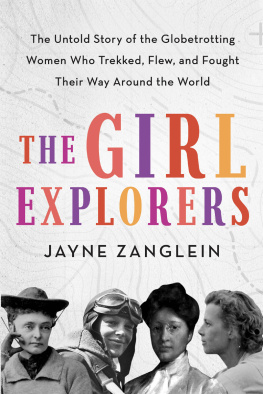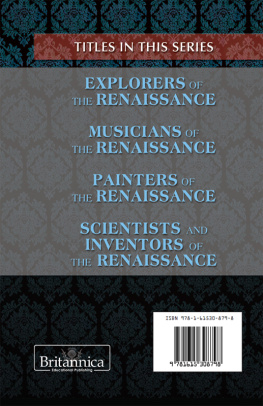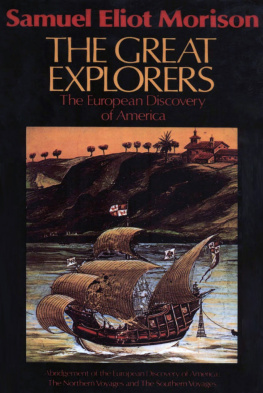To the Ends of the Earth
To the Ends of the Earth
The Age of the European Explorers
Peter O. Koch
Copyrighted image removed by Publisher
McFarland & Company, Inc., Publishers
Jefferson, North Carolina, and London
All photographs were provided by the Library of Congress.
Library of Congress Cataloguing-in-Publication Data
Koch, Peter O., 1953
To the ends of the earth : the age of the European explorers /
Peter O. Koch.
p. cm.
Includes bibliographical references and index.
ISBN-13: 978-0-7864-1565-6
softcover : 50# alkaline paper
1. Discoveries in geographyEuropean. I. Title.
G80.K57 2003
910'.92'24dc21
2003007122
British Library cataloguing data are available
2003 Peter O. Koch. All rights reserved
No part of this book may be reproduced or transmitted in any form or by any means, electronic or mechanical, including photocopying or recording, or by any information storage and retrieval system, without permission in writing from the publisher.
Cover art 2003 PicturesNow.com
Manufactured in the United States of America
McFarland & Company, Inc., Publishers
Box 611, Jefferson, North Carolina 28640
www.mcfarlandpub.com
For Abelene, Eric, Alex and Sara
Preface
I have tried in this book to dispel many of the old myths and modern prejudices that have succeeded in distorting the truth about the many European explorers who dared to go where others feared to tread. The story of these voyages of discovery has become, especially in recent times, a subject shrouded in controversy: no longer seen as heroes, except in their respective homelands, these bold explorers are now viewed as purposeful purveyors of disease, destruction, and slavery. As part of a concerted effort to discredit the documented accomplishments of the many seafarers who hailed from the shores of the Iberian Peninsula, a rash of revisionist writers, historians, and archaeologists have promoted a number of alternative theories about the true discoverers of routes to unknown lands and unfamiliar civilizations. We are now told that Egyptian sailors ventured far enough westward to lay claim to the lands opposite the known world long before the Europeans ever set sail, and they were followed by African mariners who rowed across a vast ocean to leave their own indelible imprint upon the ancient civilizations of Central America. Conjecture that Polynesian, Japanese, Chinese and Indian mariners sailed to either North, South, or Central America centuries before the epic voyage of Christopher Columbus has managed to become the basis of fact. With authors and publishers promoting such titillating interpretations of historical events that may or may not have occurred, the uninformed reader is denied access to what is the truth. History, as we discover, is far more compelling and often more interesting than fiction.
While there have certainly been many excellent biographies published about the individual discoverers of this era, there are few books that tell the collective story of the numerous explorers who ventured forth during this epic period. Most of these explorers were born to the same generation and a great many sailed together on these voyages of discovery. Within these pages lies the story within the story, for it was these joint ventures and shared experiences that ultimately led to the discovery of new lands and unknown civilizations.
Ever since his emergence on earth, man has endeavored to learn more about his immediate surroundings, and to this end he has continued to expand horizons for future generations. By various modes of transportation, he has ventured forth into the great unknown, and every step of the way he has discovered not only something new about the world around him but also learned a bit more about his own nature. In his eternal quest for answers, man has had to endure the harshest forces of nature, overcome seemingly insurmountable obstacles, and learn to confront his fears. For those fortunate enough to have reached the journeys end there were the earthly rewards of discovering a new land, crossing an unknown body of water, or encountering the wondrous marvels of another civilization.
Beginning with the worldly vision of Prince Henry the Navigator and concluding with the Homeric odyssey of Ferdinand Magellan, this book tells of the daring exploits, the great triumphs, and the terrible tragedies that befell the many bold explorers who sought to discover a route to the splendid treasures of the Far East. Motivated by a lust for wealth, a taste for spices, and a penchant for adventure, these intrepid sailors forever changed our perception of the world around us. This is a tale that started out as a religious crusade, a blind faith quest that led to the discovery of many earthly delights. It was Muslim merchants who first introduced the European palate to a vast assortment of rare spices and other unusual and exotic items that had their origins in a mysterious region of the world commonly referred to as the Indies. The spices that reached the many markets scattered throughout Europe came in a variety of forms and had a vast array of uses, but the spices that excited European senses the most were those that enhanced the flavor of food, produced a pleasing aroma, or possessed medicinal value. A burning desire to acquire that which did not come naturally to them evolved into a unique European trait, one which, besides sowing the seeds of capitalism, instilled the widely accepted concept that conquest and colonization could be justified as part of a grand schemea manifest destiny sanctioned in the name of Christianity.
This European race to become the first to reach the legendary lands of the Indies by way of the sea pitted the tiny nation of Portugal against its much larger neighbor Spain. While the emphasis of this book is on the many voyages of discovery launched from the shores of the Iberian Peninsula, the major contributions of another European peninsula have not been overlooked. Though they may have sailed under the flags of other nations, Christopher Columbus, Amerigo Vespucci, and John Cabot are explorers forever linked by a common heritagethey were all proud sons of Italy. These adventurous-minded foreigners had a great deal in common with visionary men such as Prince Henry the Navigator, Bartolomeu Dias, Vasco da Gama, and Ferdinand Magellan of Portugal as well as Alonso de Ojeda, Vicente and Martn Pinzn, Vasco Nez de Balboa, and Juan Sebastin del Cano of Spainin particular, a desire to discover a pathway to the treasures of the Far East.
My aim is to present this intriguing tale of discovery in as clear, concise and objective a manner as possible. This book offers a glimpse into the dreams, fears, disappointments, and triumphs of the many men who dared to face the perils of the great unknown. Together we shall stand beside Christopher Columbus at the shores of Hispaniola, sail along the virgin coast of South America with Amerigo Vespucci, march through the dense jungles of Panama with Vasco Nez de Balboa, and bravely fight alongside Ferdinand Magellan at the Battle of Mactan. It is my hope that the reader will gain a better understanding of the major events and various circumstances, which, when combined, culminated in one of the most significant periods in all of history. These were the voyages of discovery that helped to tear down longstanding barriers, explode age-old myths and misconceptions, and broaden our horizons until finally, the world was made whole.
Those who have never seen themselves surrounded on all sides by the sea can never possess an idea of the world, and of their relation to it.
Johann Wolfgang von Goethe
ONE
The Routes of Trade
Europe Awakens
The fatal depth to which the once mighty Roman Empire had fallen became clearly evident to the rest of the civilized world when Alaric, the king of the wandering Visigoths, conquered and ransacked the imperial city of Rome in a.d. 410. The Visigoths, along with the Lombards, Vandals, and Ostrogoths, had terrorized the borders of the vast Roman frontier for a number of decades prior to this invasion. These Germanic tribes, all of whom were being forced from their homelands by invading Hun armies, grew bolder with each victory over the faltering legions of Roman soldiers, and before long these barbarians had pushed their territorial claims to the very gates of the ancient city that had once lorded over much of the known world. Rome managed to survive the indignity of this brief occupation only to fall again in 455, this time to the hordes of migrating Vandals. The fall of the Western Empire became complete with the capture of the young Emperor Romulus Augustulus in 476 by Germanic warriors who had once pledged their allegiance to Rome.










